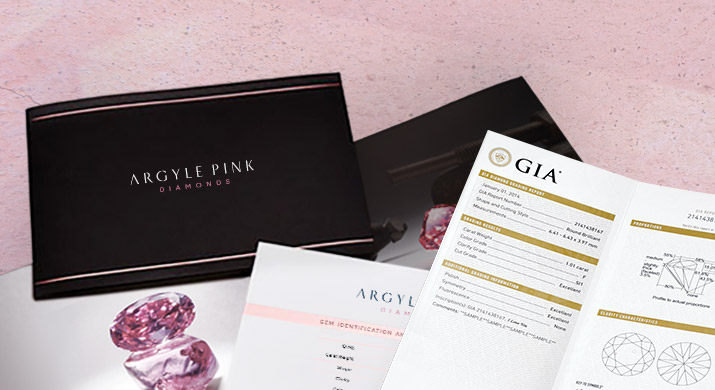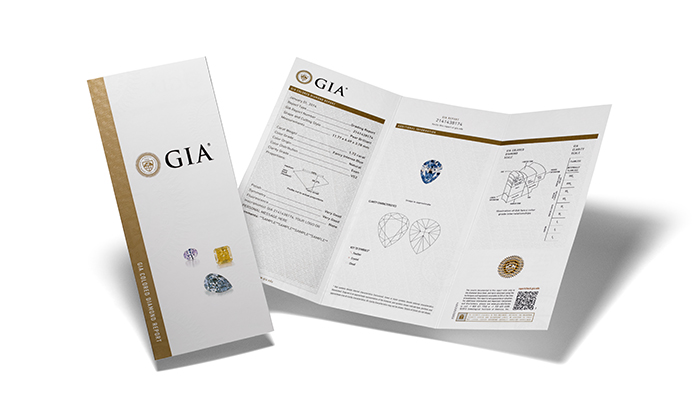Everything you need to know about the GIA & Argyle diamond certification

When it comes to purchasing a rare, fancy coloured diamond, certification is essential. Authenticating a diamond’s status as a natural diamond, and listing the specific characteristics of the stone will conclusively identify its value, clarity, and grading scale.
Many different gemological laboratories around the world issue diamond reports; however, Nina’s recommends purchasing stones with GIA certification or a report direct from Argyle Pink Diamonds. These two diamond reports are internationally recognised, and the most traded reports on the market for both coloured and colourless diamonds.

What is an Argyle Diamonds Gem Identification and Authenticity Document?
The Argyle Pink Diamonds Gem Identification and Authenticity Document is a report issued directly from the Argyle mine.
The report delivers a guarantee on the chain of custody from the mine to the point of purchase. This report denotes that the gem has always been in the care of Argyle Pink Diamonds and its trusted trade partners. Also, every Argyle diamond greater than eight points, or 0.08 carats, is laser inscribed with a unique lot number engraved into the girdle. This number is visible only under magnification, and forever links it to the report for conclusive identification.
What is Argyle Certification?
Pink diamonds polished in the Argyle mine and sold by Argyle Diamonds are given an Argyle Certificate.
The Argyle Certification contains a description of the unique characteristics of the Argyle diamond based on the proprietary grading techniques of Argyle Diamonds. The certification lists the stone’s weight, shape, colour, and clarity grading from Argyle.
Why would someone need an Argyle Grading Certificate?
Pink diamonds sourced, selected, cut and prepared by the experts at Western Australia's Argyle diamond mine are extremely rare!
Jewelers will often purchase rough pink diamonds directly from Argyle mine, and then cut and polish the diamonds in-house. These diamonds often do not come with an Argyle Certification. While still lovely, an Argyle pink diamond without an Argyle Certificate has not been selected, cut and prepared by the Argyle diamond mine for purchase.
These diamonds are not as rare and therefore, not as prized as an investment piece or family heirloom. Only a handful of exclusive and carefully selected jewelers offer Argyle Pink Diamonds complete with Argyle certifications, and given the title of Argyle Pink Diamond Select Ateliers. Nina’s is one of the few Argyle Pink Diamonds Select Ateliers in the world.
What is the Argyle grading method?
The Argyle colour grading scale is separated into three different hues for pink diamonds:
- PP or purplish pink
- P which is a straight pink
- PR which stands for pink rose or rosy pink
The three colours are divided into nine intensities with prefixes of one to nine. An Argyle diamond grading with a one is the deepest intensity while nine would be the lightest. Also, the Pink Champagne or PC colour profile grades the diamonds that have a brown body colour with pink as their secondary hue. Intensities are reversed for this colour range. A PC1 diamond would be the lightest and PC9 would be darkest.
The Argyle mine also recognises two red colours - ‘Red’ and ‘Purplish Red’. These diamonds are incredibly rare, and along with ‘Blue Violet’ is also graded with grades BL1 and BL3.

What are GIA Coloured Diamond Grading Reports?
In a GIA grading report and certification, purchasers get a full-quality assessment of a coloured diamond, including colour grade, colour origin, carat weight, and clarity, along with a plotted diagram of the stone’s clarity characteristics. The GIA report also lists a unique serial number laser inscribed into the diamond, forever linking it to its specific GIA report.
What’s the history of GIA grading?
 In the early 1940s, the world’s largest and most respected nonprofit institute of gemological research and learning established the GIA Coloured Diamond Grading Report. GIA founder Robert M. Shipley was a former retail jeweler looking to professionalise the jewelry industry. The GIA was created to give jewelers formal training and to establish standards and ethics in buying and selling diamonds and other precious stones. Shipley developed the four C’s grading system to help his students remember the characteristics of a diamond.
In the early 1940s, the world’s largest and most respected nonprofit institute of gemological research and learning established the GIA Coloured Diamond Grading Report. GIA founder Robert M. Shipley was a former retail jeweler looking to professionalise the jewelry industry. The GIA was created to give jewelers formal training and to establish standards and ethics in buying and selling diamonds and other precious stones. Shipley developed the four C’s grading system to help his students remember the characteristics of a diamond.
Why ask for a grading report?
Grading reports give purchasers the precise characteristics of the diamond, including color, cut, clarity, and carat weight.
How does GIA grading differ from the Argyle grading method?
GIA grading describes a stone’s colour based on tone, hue, and saturation. Hue is the stone’s characteristic colour, while tone indicates whether the stone is light or dark. Saturation refers to how intense or deep the stone’s colour is. GIA colour graders select from one to 27 hues, and will describe the saturation and tone of the diamond with words like “fancy vivid,” “fancy intense,” or “fancy light.”
Most GIA graded diamonds will fall somewhere on a D to Z colour range. But occasionally, a natural brown, blue, pink, yellow, or even green diamond will be mined. These diamonds are incredibly rare, distinct, and therefore, highly prized. Fancy coloured stones such as the Argyle Pink Diamonds are evaluated on scales that emphasise colour intensity. Shades that are deep and vibrant are often rated higher on the Argyle colour grading scale than paler gems.
A rare and fancy coloured stone from Argyle mines will hold and increase its value over time. Purchasing one complete with Argyle Certification reassures buyers of the stone’s exceptional origin, colour, and intensity.
To learn more about Argyle pink diamonds, download our Argyle Pink Diamond Buying Guide. Alternatively, get in touch with our team with any specific questions about GIA & Argyle diamond certification.







The information below is required for social login
LOG IN
Create New Account